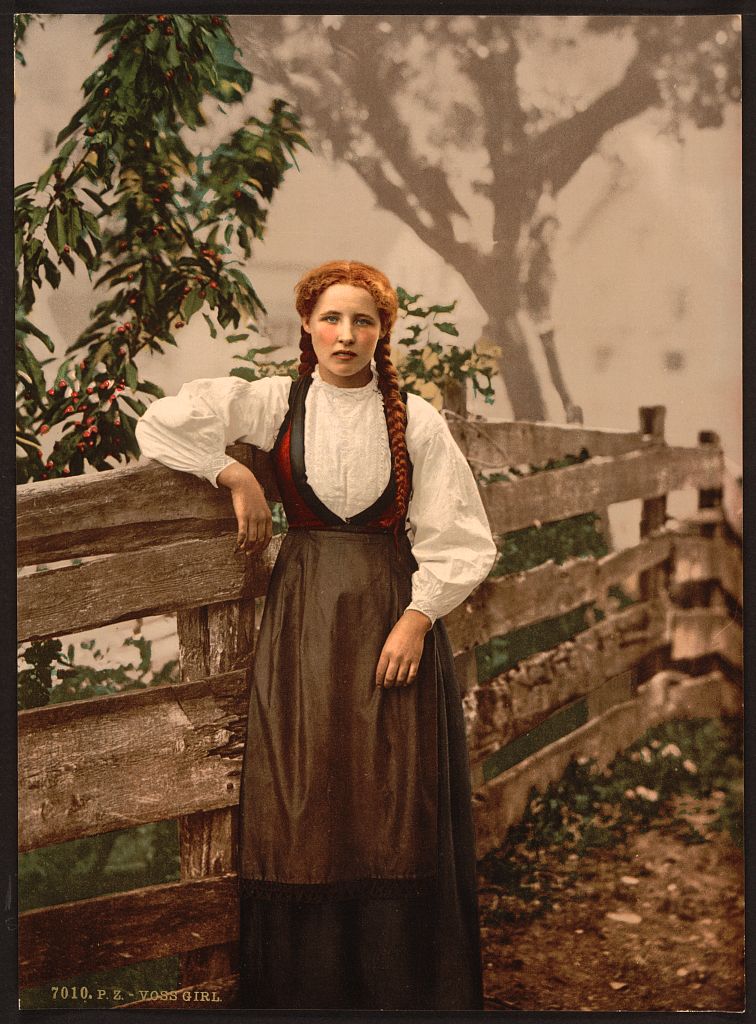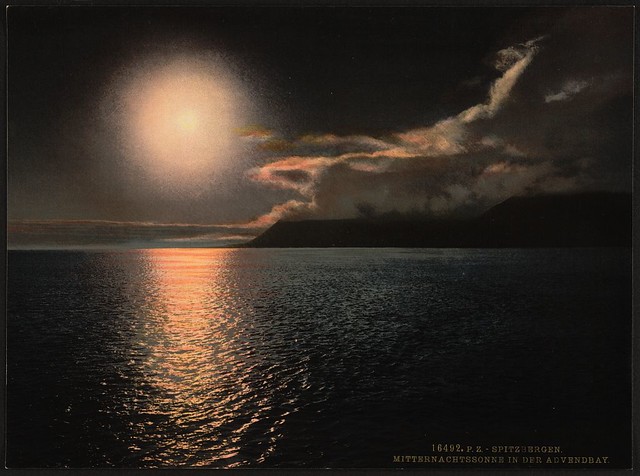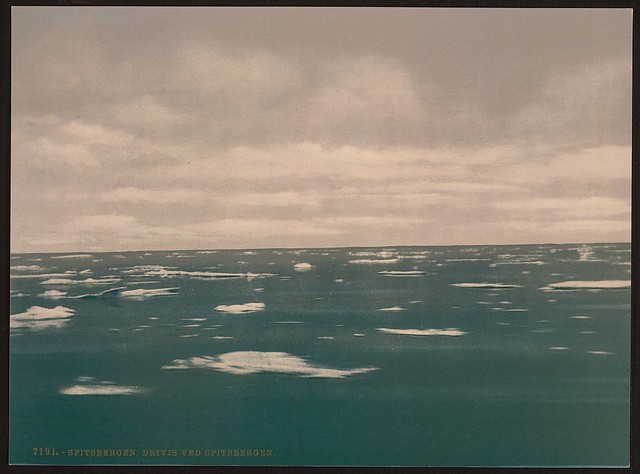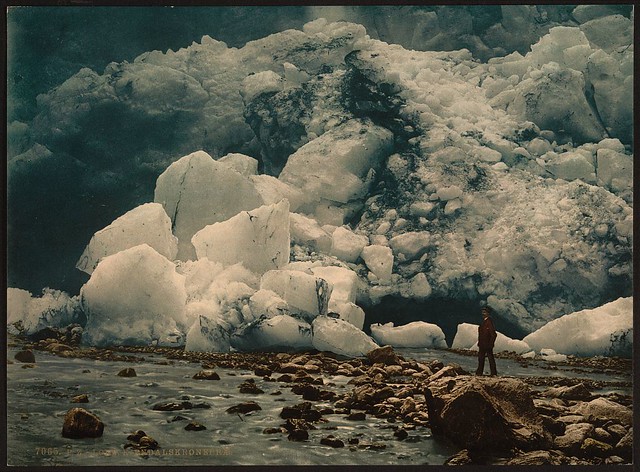
A girl of Voss, Hardanger Fjord, Norway, c. 1890: photochrome print, Detroit Publishing Co., 1905 (Library of Congress)
Falling over hisself with
his tumbledown longing
giving out the raggedy
signs
with a
dirty brush
Glamour, disarming
scorning the
polished demand
seeping between the fingers
held over the
eyes
Blossoming: the
burst sea wall
remembered here
and here
the hundreds of arcing stars
duffing up the
hung up dark
and the Norwegian
girl
drunk and
in tears and
not in love
and not in
love

Midnight sun at Advent Bay, Spitzbergen, Norway, c. 1890: photochrome print, Detroit Publishing Co., 1905 (Library of Congress)

Advent Bay, Spitzbergen, Norway, c. 1890: photochrome print, Detroit Publishing Co., 1905 (Library of Congress)

Drifting ice, Spitzbergen, Norway, c. 1890: photochrome print, Detroit Publishing Co., 1905 (Library of Congress)

Loen, Kjendalskronebrae, Nordfjord, Norway, c. 1890: photochrome print, Detroit Publishing Co., 1905 (Library of Congress)
Wooden Boy: Tales from the School of Art, from The Little Wooden Boy, 10 June 2012



16 comments:
Caught between rocks and a glacier--good morning!
"He doth protest too much!" she said.
Tom,
Oh boy, "duffing up the hung up dark . . . and the Norwegian girl drunk"
and the midnight sun lives on, presiding over us all
6.25
light coming into fog against invisible
top of ridge, sparrow landing on branch
in foreground, sound of wave in channel
sitter in graphite approach,
figure following week
that sometimes come to pass,
this itself, but what
silver line of sun reflected in channel,
white cloud in pale blue sky on horizon
Steve, those are the words I most love too... through the pall of smoke created by my nth braindamaged forgetting that the rubber band which secures the toaster trigger is on fire (along of course with the toast).
"duffing up the hung up dark . . . and the Norwegian girl drunk"
It would take someone (else) (like you, O craft master Ratcliffe) with an ear for the unusual and exceptional vowel sound clusters that link up English as affected by the Normans with the languages of the midnight sun, which lives on, lives on, presiding over us all, to recognize the genius in those lines.
I think of it as a gift.
sitter in graphite approach,
figure following week
that sometimes come to pass,
this itself, but what
The distances there are painful, familiar or made familiar in this. The difference made foreign, Norwegian, and then becomes story-like in its ending. A remembrance. I like how things are shuffled around in the beginning about art and then sift into a funnel or place themselves with a declaration. It is hopeful because it ends in the middle of things. A poem of long summer days when so much happens and people change so much within one day up in the Arctic.
I take the remarkable sound patternings in Wooden Boy's poems as a basic next step forward.
Eric Stewart of 10 CC on "I'm Not in Love":
After saying he didn't like it, he said "Let's do something very different. Now let's do a whole track and the whole backing track is voices".
Right. Which hadn't been done before.
Not that I know of, except for acapella, going back to old religious monks singing in churches, but we needed something to keep a rhythm so Kevin said "well, I'll play a bass drum sound on a Moog, just going 'dum duhdum dum duhdum dum duhdum'. You couldn't actually hear a note actually as you can on this Rhodes, so it was just a boof baboof boof baboof and a little rhythm guitar. Um, Graham played the rhythm guitar and I sat down on the Fender Rhodes and tried to figure the chords on the Rhodes.
Right.
[Plays Rhodes] then we had to figure how to do a backing using purely voices. And it took us 3 weeks of recording single chants of everybody in the studio, including Godley, Creme and Gouldman, with me engineering. Them in the studio just going aaahhhh aaaahhh (up a note!). then me linking them all together, taking sixteen tracks of these aaahhh's then mixing them down to one track. So eventually we had a chromatic scale of 13 notes [plays 13 ascending notes on Rhodes] of aaahhh's on this tape plus one little stereo backing track with a bass drum on it and a rhythm guitar for timing. Then I had to mix those sixteen tracks across to a stereo pair, to give us the whole vocal backing before the lead vocal was put on. So we, we'd run out of tracks. A way we developed to do it, we, we made some tape loops in the studio um, which were about 16 feet long so you wouldn't have a loop going ah ah ah ah. This loop would have a little blip where the tape join was about every sixteen feet, then I put them on the control desk and put a piece of gaffer tape just underneath the faders so that all the notes, even though it was a chromatic scale and quite dischordant if you listen to them solo, it was just sizzling underneath the backing bass drum and rhythm. And then four of us got on the control desk as the song was played and started pushing the faders up and down as the chords were changing. And we had every note written on the faders on the desk so "ah oh ah oh" with this "haaaaaaahhhhhhhh" always there sustaining in the background. I put the lead vocal on it and we came in and we said God we got something here but I don't know what we're gonna do, what are we gonna do with it? And at that point in time we were still on Jon, on Jonathan King's label, but struggling. We were, we were absolutely skint, the lot of us, we were really struggling seriously, and Philips Phonogram wanted to do a deal with us. They wanted to buy Jonathan King's contract. I gave, I rang them. I said come and have a listen to what we've done, come and have a listen to this track. And they came up and they freaked, and they said "This is a masterpiece. What, how much money, what do you want? What sort of a contract do you want? We, we'll do anything, we'll sign it".
It was a number one.
Everywhere.
Absolutely, and a revolutionary track really, and it's taken ages to put together. Now of course, you could do that vocal sound on a, on a computer.
On a computer. It's a doddle, yeah, it's a doddle.
Yes it's terrible, we throw caution to the winds and find a vowel dripping from the lip of a fjord. And here we hadn't even known we were all that familiar with the fauna!
We here viewed the art school milieu of this circle of the Arctic through the period lens of that 10 CC video.
And yes, Susan, the raggedy foxlike artschool semiotics, the sifting funnel, the truth seeping through the fingers as when the fridge is being defrosted, here in the Arctic summers -- it has never seemed so warm.
The carbon.
The remembrance of the refusals seems an implicit declaration in itself.
Redundancy be damned,I must repeat what Steve said and Tom reiterated about WB's "duffing up the hung up dark. . .and the Norwegian girl drunk"
No -- I mean yes -- No, originality is terribly over-rated, redundancy has always been the soul of poetry!
not in love and not in love
The fear of repeating oneself is known to be an Esquimaux-kissing cousin to a fear of poetry.
The most poetic character in the history of cinema is Jimmy Two-Times.
Get the babies! Get the babies!
Increase the population of Norway!
The Norwegian photo tone poem does the poem's exquisite music mythic justice. Makes the implicit declaration explicit as shifting trysts of ice and fire, rare fauna frozen "in the middle of things". I'm startled to see arcing in the midnight sun's reflection on giant clouds the man-in-the-moon likeness of Ted Hughes' face (ha, floating off the cover of his Collected Poems -- that chin, nose, and faraway eyes right there).
And while we're on about repetitions, which I think even more prose writers could well afford to reconsider as a necessity, and those timpanic d's, which are surely this poem's beating heart, let us also appreciate the slightly more demure, arising from and returning to the horizon, the h's -- "hisself," "held," "here and here," "hundreds," hung," and (my favorite, for its playful intrusion of sound over sight), "Norwegian." Great piece.
There is a great expressive exHalation of feeling in watching The Indian Girls of the 4-H Club at play.
I am the girl of Voss
watching the Indian girls
of the 4-H Club at play
saving up
for the time
when I will run
as they do
over the dusty ground
with pants
and not checking the clouds
and not looking for
my reindeer
or where commas may
go or not go
Commas have been thrown to the winds, and one has been left to float in free fall, like a disabled boomerang, faintly but unmistakably curling about the top right of the photo -- while below, in the distance, someone is holding onto someone's hat.
An expansive, elemental photograph, its contagious energy tempting the girl of Voss, luring her away from the fjords, toward the New World, perhaps forever.
Post a Comment